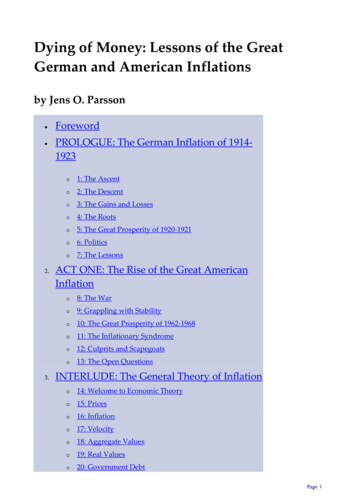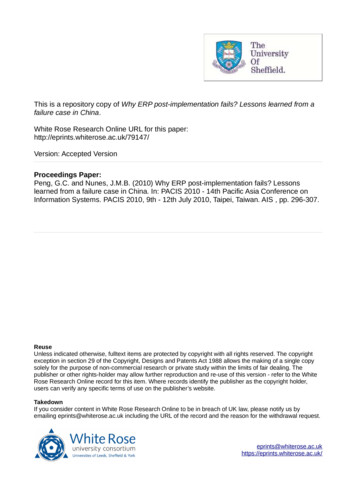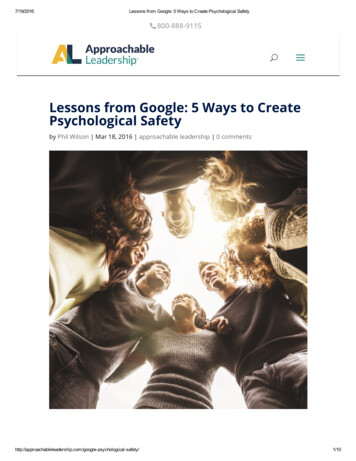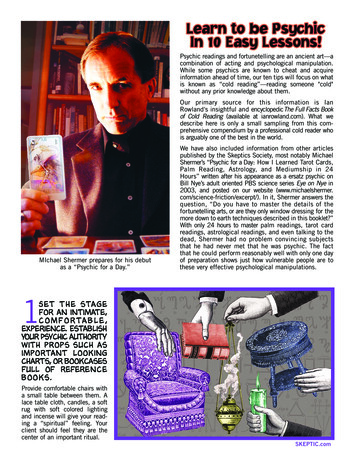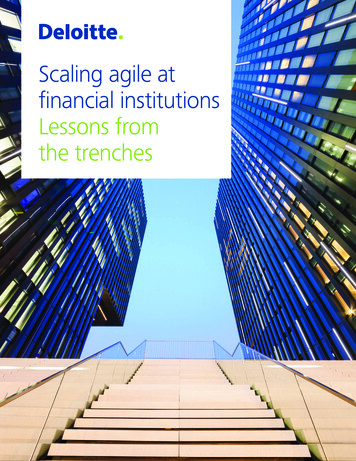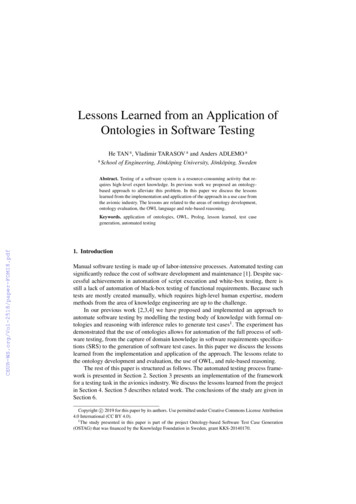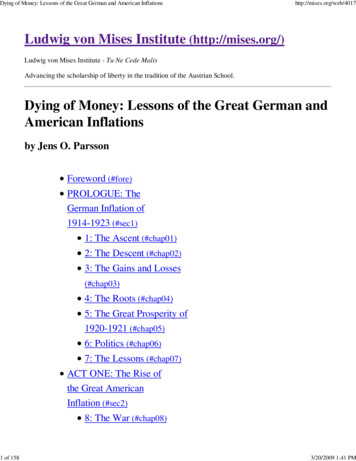
Transcription
Dying of Money: Lessons of the Great German and American Inflations1 of 158http://mises.org/web/4017Ludwig von Mises Institute (http://mises.org/)Ludwig von Mises Institute - Tu Ne Cede MalisAdvancing the scholarship of liberty in the tradition of the Austrian School.Dying of Money: Lessons of the Great German andAmerican Inflationsby Jens O. ParssonForeword (#fore)PROLOGUE: TheGerman Inflation of1914-1923 (#sec1)1: The Ascent (#chap01)2: The Descent (#chap02)3: The Gains and Losses(#chap03)4: The Roots (#chap04)5: The Great Prosperity of1920-1921 (#chap05)6: Politics (#chap06)7: The Lessons (#chap07)ACT ONE: The Rise ofthe Great AmericanInflation (#sec2)8: The War (#chap08)3/20/2009 1:41 PM
Dying of Money: Lessons of the Great German and American Inflations2 of 158http://mises.org/web/40179: Grappling with Stability(#chap09)10: The Great Prosperityof 1962-1968 (#chap10)11: The InflationarySyndrome (#chap11)12: Culprits andScapegoats (#chap12)13: The Open Questions(#chap13)INTERLUDE: TheGeneral Theory ofInflation (#sec3)14: Welcome toEconomic Theory(#chap14)15: Prices (#chap15)16: Inflation (#chap16)17: Velocity (#chap17)18: Aggregate Values(#chap18)19: Real Values (#chap19)20: Government Debt(#chap20)21: The RecordInterpreted (#chap21)22: Money (#chap22)3/20/2009 1:41 PM
Dying of Money: Lessons of the Great German and American Inflations3 of 158http://mises.org/web/401723: The Creation ofMoney (#chap23)24: Depression (#chap24)25: The Economics ofKeynes (#chap25)26: InflationaryEconomics (#chap26)27: Interest and theMoney Wealth (#chap27)28: The Economics ofDisaster (#chap28)29: The Crux (#chap29)30: Taxes (#chap30)31: American Taxes(#chap31)32: GovernmentExpenditure: The NationalDividend (#chap32)33: Employment (#chap33)34: Investment andGrowth (#chap34)35: Dogma (#chap35)THE LAST ACTS: TheAmerican Prognosis(#sec4)36: Act Two, Scene One:President Nixon Begins3/20/2009 1:41 PM
Dying of Money: Lessons of the Great German and American Inflations4 of 158http://mises.org/web/4017(#chap36)37: Act Two, Scene Two:Price Controls and OtherFollies (#chap37)38: The Way Out(#chap38)39: The Way Ahead(#chap39)40: Democratics (#chap40)41: PoliticalReorganization (#chap41)42: Self Defense (#chap42)43: Self DefenseContinued: The StockMarket (#chap43)44: A World of Nations(#chap44)45: Interscript (#chap45)Notes (#sec5)ForewordMost of us have at least a general idea of what we think inflation is. Inflation is the state of affairs in whichprices go up. Inflation is an old, old story. Inflation is almost as ancient as money is, and money is almost asancient as man himself.It was probably not long after the earliest cave man of the Stone Age fashioned his first stone spearhead tokill boars with, perhaps thirty or forty thousand years ago, that he began to use boar's teeth or something ofthe sort as counters for trading spearheads and caves with neighboring clans. That was money. Anything likethose boar's teeth that had an accepted symbolic value for trading which was greater than their intrinsic valuefor using was true money.Inflation was the very next magic after money. Inflation is a disease of money. Before money, there could be3/20/2009 1:41 PM
Dying of Money: Lessons of the Great German and American Inflations5 of 158http://mises.org/web/4017no inflation. After money, there could not for long be no inflation. Those early cave men were perhapsalready being vexed by the rising prices of spearheads and caves, in terms of boar's teeth, by the time theybegan to paint pictures of their boar hunts on their cave walls, and that would make inflation an olderinstitution even than art. Some strong leader among them, gaining greater authority over the district byphysical strength or superstition or other suasion, may have been the one who discovered that if he coulddecree what was money, he himself could issue the money and gain real wealth like spearheads and caves inexchange for it. The money might have been carved boar's teeth that only he was allowed to carve, or it mighthave been something else. Whatever it was, that was inflation. The more the leader issued his carved boar'steeth to buy up spearheads and caves, the more the prices of spearheads and caves in terms of boar's teethrose. Thus inflation may have become the oldest form of government finance. It may also have been theoldest form of political confidence game used by leaders to exact tribute from constituents, older even thantaxes, and inflation has kept those honored places in human affairs to this day.Since those dim beginnings in the forests of the Stone Age, governments have been perpetually rediscoveringfirst the splendors and later the woes of inflation. Each new government discoverer of the splendors seems tobelieve that no one has ever beheld such splendors before. Each new discoverer of the woes professes not tounderstand any connection with the earlier splendors. In the thousands of years of inflation's history, there hasbeen nothing really new about inflation, and there still is not.Around the year 300 A.D., the Roman Empire under the Emperor Diocletian experienced one of the mostvirulent inflations of all time. The government issued cheap coins called "nummi," which were made ofcopper washed with silver. The supply of metals for this ingenious coinage was ample and cheap, and thesupply of the coinage became ample and cheap too. The nummi prices of goods began to rise dizzily. PoorEmperor Diocletian became the author of one of the earliest recorded systems of price controls in an effort toremedy the woes without losing the joys of inflation, and he also became one of the earliest and mostdistinguished failures at that effort. The famous Edict of Diocletian in 301 decreed a complex set of ceilingprices along with death penalties for violators. Many death penalties were actually inflicted, but prices werenot controlled. Goods simply could not be bought with nummi. Like every later effort to have the joys withoutthe woes of inflation, the Edict of Diocletian failed totally.So it has gone throughout the millennia of man's development. For at least the four thousand years ofrecorded history, man has known inflation. Babylon and Ancient China are known to have had inflations. TheAthenian lawgiver Solon introduced devaluation of the drachma. The Roman Empire was plagued by inflationand, more rarely, deflation. Henry the Eighth of England was a proficient inflationist, as were the kings ofFrance. The entire world underwent a severe inflation in the sixteenth and seventeenth centuries as a result ofthe Spanish discoveries of huge quantities of gold in the New World. "Continentals" in the AmericanRevolution and the assignats in the French Revolution were precursors of the wild paper inflations of thetwentieth century. Steadily rising prices have been the general rule and not the exception throughout man'shistory.The twentieth century brought the institution of inflation to its ultimate perfection. When economic systemsare so highly organized as they became in the twentieth century, so that people are completely dependent onmoney trading for the necessaries of life, there is no place to take shelter from inflation. Inflations in thetwentieth century became like inflations in no other century. The two principal inflations that occurred inadvanced industrial nations in the twentieth century will probably prove to have done more to influence thecourse of history itself than any other inflation. One of these was the German inflation that had its roots inWorld War I, grew to a giddy height and a precipitous fall in 1923, and contributed to the rise of Adolf Hitlerand World War II. The other was the great American inflation that had its roots in World War II, grew in thedecade of the 1960's toward an almost equally giddy height, and contributed to results which could not evenbe imagined at the time this book was written.This book is not a history of inflation, because most inflations of history hold only a passing interest. This3/20/2009 1:41 PM
Dying of Money: Lessons of the Great German and American Inflations6 of 158http://mises.org/web/4017book is written primarily about the great American inflation, and it was written at a time when that inflationwas still in mid-career. No one then knew where it might end, but it seemed altogether possible that noinflation of history, not even the German, would appear in retrospect to have troubled the waters of timemore deeply than the great American inflation.Inflations may be of every conceivable variety of degree, from the mildly annoying to the volcanic. Inflationsmay be fast or slow, accelerating or decelerating, chronic or transitory. A merely annoying inflation usuallycauses no one very much real harm. A volcanic inflation, on the other hand, is the kind of catastrophe thatconfiscates wealth, withholds the means of life, breeds revolutions, and precipitates wars. Every volcanicinflation of history began as a mildly annoying inflation. The true nature of any inflation is not often visible onits surface. As with volcanoes, an annoying inflation that is about to subside and die out looks on its surfacelike one that is about to erupt. It is the disquieting nature of an inflation that no one knows with certaintywhat it will do next.The era of the inflation in the United States was an era of many kinds of discomforts. The nation was fightinga small but dismal and unpopular war in distant Southeast Asia. Crime was rampant. Cities were degenerating.Negroes were in ferment, students in rebellion, and youth in general in a state of defection. The illness ofinflation might have been lesser or greater than any of these. It might have had nothing to do with any otherillness, or it might have lain near the root of them all. There were those who dismissed the inflation as theleast of the panoply of American illnesses, but they were less numerous than formerly and might be still lessnumerous later.Scarcely a person in America was untouched by inflation's handiwork. Every citizen, in his daily life and withhis earthly fortune, danced to a tune he mostly could not hear, played for him by the government's inflation. Itwas up to every citizen to learn for himself what was happening and to look out for himself if anyone wasgoing to, because no one else was looking out for him. The government certainly was not. The governmentwas compelled by its other duties not to protect him but the opposite, to continue to steal from him by theinflation as long as it could. The forces at work were such that there was no practical possibility the inflationwould end or abate. The only real question was whether or not it would continue to become steadily worse. Ahundred million Americans or more, almost all of them serenely unwitting, lived their lives and made theirhomes on inflation's epicenter. They were on ground zero for inflation's shock waves. Only time would tellwhether the tremors rumbling beneath their feet would pass off without a quake.The past is prologue, it is said. No more instructive prologue to the American inflation, which was stillunfinished, could be chosen than the German inflation, which was long since completed. Let us begin then byturning first to that inflation and taking our text for the day from the scripture of history.PROLOGUE: The German Inflation of 1914-19231: The AscentIn 1923 Germany's money, the Reichsmark, finally was strained beyond the bursting point, and it burst.Persistent inflation which had steadily eroded the mark since the beginning of World War I at last ran away.Germany's "disastrous prosperity" came to an end, and in its place the German people suffered a period ofhardship and real starvation as well as a permanent obliteration of their life savings. When the debacle wasfinally stopped, the old mark, which had once been worth a solid 23 cents, was written off at one trillion oldmarks to one new one of the same par value. The most spectacular part of that loss was lost in the mark's finaldizzy skid; all the marks that existed in the world in the summer of 1922 (190 billion of them) were not worthenough, by November of 1923, to buy a single newspaper or a tram ticket. That was the spectacular part ofthe collapse, but most of the real loss in money wealth had been suffered much earlier. The first 90 percent of3/20/2009 1:41 PM
Dying of Money: Lessons of the Great German and American Inflations7 of 158http://mises.org/web/4017the Reichsmark's real value had already been lost before the middle of 1922.The tragicomic denouement of Germany's inflation — the workers hastening to the bake shops to spendquickly their day's pay bundled up in billions of paper marks and carried in wheelbarrows — is perhaps atleast vaguely remembered nowadays. The more sinister and more permanent scars which the inflation left areless well known. Still less clearly remembered are the years before the mark blew, with their breakneck boom,spending, profits, speculation, riches, poverty, and all manner of excess. Throughout these years the structurewas quietly building itself up for the blow. Germany's inflation cycle ran not for a year but for nine years,representing eight years of gestation and only one year of collapse.The beginning was in the summer of 1914, a day or two before World War I opened, when Germanyabandoned its gold, standard and began to spend more than it had, run up debt, and expand its money supply.The end came on November 15, 1923, the day Germany shut off its money pump and balanced its budget.Over the nine years in between, Germany's inflation followed not a constant course but a characteristic ascentand descent, a ripening and a decay.Germany started by not paying adequately for its war out of the sacrifices of its people — taxes — butcovered its deficits with war loans and issues of new paper Reichsmarks. Scarcely an eighth of Germany'swartime expenses were covered by taxes. This was a failing common to all the combatants.
The money might have been carved boar's teeth that only he was allowed to carve, or it might have been something else. Whatever it was, that was inflation. The more the leader issued his carved boar's teeth to buy up spearheads and caves, the more the prices of spearheads and caves in terms of boar's teeth rose. Thus inflation may have become the oldest form of government finance. It may also .

